
Meyou examines how Auras fundamentally work and presents arguments for new paradigms regarding Aura design and usage.
It can be intriguing to look back at some of my old writing.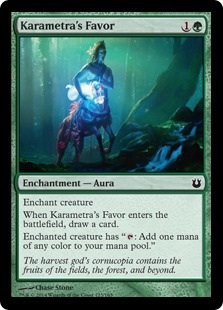
The Aura Combo
If Auras are bad, why make them? For one, a large segment of the Magic populace loves them. Many of these players tend to be new players. However, there is a small niche of players who still love their Auras regardless of being bad to play. Part of the attraction is the customization of creatures. It is fun to make bigger and better creatures on the board, especially when it becomes an 11/11 monstrosity with lifelink, first strike, trample, and flying. Eventually, we learn about that pesky thing called card advantage. In the case of Auras, it is card disadvantage. Getting our Voltron hit by a simple Doom Blade sends the Aura(s) and the creature to the graveyard. It is classically referred as a two-for-one in which one spell destroys two permanents.
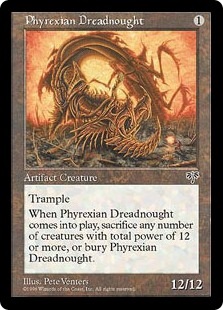
Now take sequential combos that must be played in a particular order. A classic example of this is Phyrexian Dreadnought and Stifle. I can’t cast Stifle before the Dreadnought. I have to play the Dreadnought first, immediately followed by the Stifle. I must have both cards in hand in order to complete my powerful combo. If we think of Auras through this prism, creatures and Auras are effectively a sequential combo. I can’t cast an Aura until I have a creature on the battlefield. Sequential combos are inherently a much more fragile combo because they can be more easily disrupted. After a player has cast a Phyrexian Dreadnought, I can counter the Stifle to two-for-one them. The same is true for Auras as an opponent can two-for-one me with creature removal.
Improving the Creature Combo
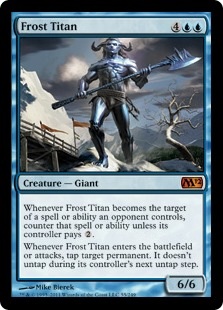
History has shown that the most powerful combo pieces are creatures with hexproof. Sometimes, those creatures are even quite laughable without the keyword. Slippery Bogle and Gladecover Scout are merely 1/1 creatures that are otherwise vanilla. However, those two creatures are the backbone to the Aura-based Modern deck called Bogles. For a time, Silhana Ledgewalker comboed with Moldervine Cloak in the Standard environment. For a moment, let’s look at an example where the creature is good and the Aura is bad. A fairly recent case was Geist of Saint Traft being enchanted with Spectral Flight. The blue Aura by no means wins any awards for super powerful enchantments. However, it turned Geist of Saint Traft into a nearly unblockable killing machine of eight damage a turn.
If R&D wants to make Auras relevant, they need to design better creatures. Specifically, creatures that combo with Auras. This doesn’t mean every creature needs to have hexproof. I believe there are many unexplored avenues. For example, I think the ability on Frost Titan is a prime candidate. Knight of the Holy Nimbus also comes to mind. If my opponent wants to remove this creature, they will have to pay an additional cost when targeting my Voltron creature with a Doom Blade. I also mention this since there are many opponents to the hexproof mechanic. Magic has already illustrated that there are other ways to make good combo creatures.
The paradigm that any creature will combo with an Aura has to be broken. It’s not how combos work. To put it another way, Dark Depths doesn’t combo with any land. Sure, a large amount of forests can be used to take counters off the legendary land. However, that is a bad combo. A good combo is pairing Dark Depths with Thespian's Stage. Such an example is a good combo. Combos use specific cards to get specific effects. Creatures shouldn’t be any different when creating combos with Auras.
Improving Auras
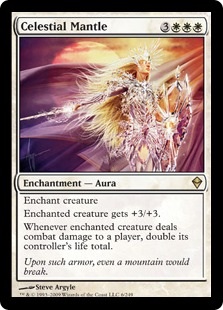
The other problem stems from power level. Auras are simply too weak. This is especially true if considering them as combo pieces. Players use combos because the combination of two or more given cards is powerful. Nobody uses Show and Tell to put a Grizzly Bears onto the battlefield. Many Auras are simply weaker than their creature equivalents at the same mana cost. Take Epic Proportions for instance. At six mana, I might as well just be playing any number of powerful creatures. At four mana, I could have had a Polukranos, World Eater. This isn’t even considering the cost of the creature that the Aura will be attached to. Not every combo has to be at the power level of Pestermite and Splinter Twin. However, the power level must be large enough that the risk outweighs the downside of playing a combo.
The current method to Aura improvement appears to be the addition of cantrip effects. Card drawing is a powerful effect, but this necessitates the weakening of the Aura. This can be seen on cards like Stratus Walk. I think this is the wrong direction. Tiny effects don’t win games. Eldrazi Conscription wins games. There is no cantrip effect on the card. It is simply good.
Playing Auras Like a Combo Deck
Suppose R&D incorporates a few of these suggestions and Auras become largely viable. There are still a few things to be understood or incorporated. To illustrate this, let’s look at the somewhat successful Bogles deck from Modern.
| Bogles: Michael Lewis 2nd Place at StarCityGames.com IQMagic OnlineOCTGN2ApprenticeBuy These Cards | ||
|---|---|---|
|
Creatures 4 Gladecover Scout 3 Kor Spiritdancer 4 Slippery Bogle Spells 1 Unflinching Courage 4 Ethereal Armor 3 Spirit Mantle 4 Spider Umbra 4 Hyena Umbra 1 Path to Exile 4 Daybreak Coronet 1 Keen Sense 3 Suppression Field 4 Rancor | Land 4 Temple Garden 1 Forest 1 Plains 1 Brushland 4 Verdant Catacombs 1 Dryad Arbor 4 Horizon Canopy 4 Razorverge Thicket | Sideboard 1 Rest in Peace 2 Grafdigger's Cage 2 Stony Silence 4 Leyline of Sanctity 2 Nature's Claim 2 Path to Exile 1 Relic of Progenitus 1 Spirit Link |
What is wrong with this list? Compare it to other combo decks. The vast majority of combo decks run tutors, cantrips, dedicated card draw, or some other way to filter through their libraries. Pod decks have Chord of Calling and Birthing Pod. Storm utilizes Serum Visions and Sleight of Hand to help find its combo pieces.
Bogles has nothing besides some card draw from Kor Spiritdancer. Without something to help find those pieces, the deck can be clunky at times. Sometimes it is stuck with no Auras for its creatures, or has no creatures for its Auras. As a true combo deck, it would be to the archetype's benefit to run cards like Sleight of Hand or Serum Visions. These cards would help the deck run more smoothly. Granted, the deck tries to alleviate these problems by running redundant combo pieces. However, this is not how traditional combo decks work. Combo runs a few of its strongest elements and tries its best to find them.
As a combo deck, splashing for blue would aid the archetype. With the reprinting of the Onslaught fetchlands, this will be very feasible. Not to mention, the addition of fetchlands will only help strengthen the mana base of the deck. The most logical addition would be the inclusion of Sleight of Hand and Serum Visions. The weakest of the Auras should be cut or at least trimmed. The addition of blue also allows the deck to run counterspells in the form of Remand or Mana Leak.
Searching For Answers to Auras
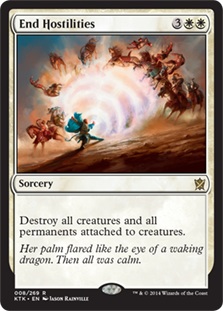
I was particularly interested because it is my belief that the available removal in a format is what dictates what archetypes will be viable. As I scanned through all the removal – even the bad – I was surprised at the sheer volume available in the game. With green acquiring the new fight mechanic, every color has access to some amount of removal. Blue even has Rapid Hybridizaiton. It was then that I noticed just how many Auras act as removal: a lot of them. Cards like Pacifism, Pin to the Earth and Domestication are considered “good” Auras. This begged the question of why? How have we arrived at this juncture? Why are Auras on my opponent’s creatures good and Auras on my creatures bad?
The problem is removal. It is powerful, it is cheap and it is everywhere. It reminds me of a recent article (Creatures in Standard - Today and Tomorrow) by Reid Duke on why creatures are bad and spells are good. In the Ravnica/Theros Standard environment, it was extremely difficult to keep a creature alive on the battlefield. If an opponent wanted to get rid of my creatures, there were many options available. This is a problem not only to Auras, but to the game.
If we want the game to be about creatures, we need to back off the removal. To be clear, removal has its place in Magic just like Wasteland does in Legacy. However, the volume and efficiency was too much during the last Standard season. It reminds me of R&D removing Counterspell from print. It was too powerful and too cheap. Too many cheap counterspells ruined the format. The same is true for removal. It may be just a blip on the radar, but the new Standard may indicate R&D is already heading down this path. This brings us back to the Aura problem. For now, it doesn’t matter how good R&D makes Auras. If we can’t keep a creature on the battlefield, how in the world can Auras ever be good? They can’t. Auras would have to be completely busted to offset the risk.
This is the reason I fully support hexproof on creatures - sparingly. I understand many players are opposed to the mechanic. I find it particularly interesting that many players don’t have a problem with protection from X, but find hexproof a horrible mechanic. Part of this problem is history. We have grown accustomed to protection and removal. We expect it. However, I disagree with history. Players shouldn’t get to do everything they want. Blue shouldn’t be able to counter everything. Black shouldn’t be able to remove enchantments. White shouldn’t get Lightning Bolts. One argument I hear repeatedly against hexproof is that it diminishes interaction in the game. Magic thrives on restrictions. It is held together by the color pie and the limitations it puts on the game. The same should hold true for removal.
Before signing off, I want to reaffirm that the argument here isn’t to slap hexproof, protection, or other removal resistance on every creature. That isn’t the game I want. I want removal to be good; it should be good. However, I believe Magic would be a better strategic game with a few more removal-resistant creatures. One axiom for draft has always been to pick removal very highly. Doom Blade was an automatic first pick. This saddens me. For a game centered on creature combat, we aren’t picking the creature first? For those wondering exactly where I stand, here is my litmus test: removal and creatures should be equal. It should be hard to make that decision. The game is more interesting when players have to weigh their choices. When picking between spells and creatures becomes automatic, that’s just bad for the game.
Meyou
-
View User Profile
-
Send Message
Posted Nov 1, 2014-
View User Profile
-
Send Message
Posted Nov 1, 2014What pains me is seeing a card like Back to Nature. It is two mana and an instant to boot. It is very aggressively costed against enchantments. No other type is that hosed. If they would have replaced enchantment with artifact, I bet there would have been some very unhappy Modern players of Robots/Affinity. Shatterstorm and Creeping Corrosion costs four and are sorceries. It is very hard to defend WotC and say there isn't a bias towards artifacts when I see something like Back to Nature.
-
View User Profile
-
Send Message
Posted Nov 2, 2014-
View User Profile
-
Send Message
Posted Nov 1, 2014For example,
G Almost-Bogle
2/1 Beast
Hexproof while enchanted.
The extra point of power would make the card less useless in other decks / formats. The opponent could still Bolt it with the aura on the stack, still allowing some interaction (which is not possible with Bogle). But once the aura lands, the combo locks in. This could alternatively be done with "indestructible while enchanted" or, if we want to prevent multiple auras, "shroud while enchanted" even.
Thoughts, anyone?
-
View User Profile
-
Send Message
Posted Oct 28, 2014Personally, I find it humorous everyone time I hear "it just dies to Doom Blade." It's iconic enough that I would love to get a T-shirt with that inscription.
Anyway, I agree that I think R&D is taking the approach of making more conditional removal like Last Breath. I think this will be good for the game in the end. We've seen this with counterspells in cards like Negate. I like that players have to make decisions when it comes to deck building and things aren't simply an auto include.
-
View User Profile
-
Send Message
Posted Nov 1, 2014LOL. Me too. I have my own expression for this, I say a creature has "DTE Syndrome", DTE standing for "Dies To Everything" (meaning, it is not black, has three or less toughness, and no regeneration, hexproof, shroud, protection, or indestructibility).
I am trying to push "DTE" as a phrase but so far having little luck.
-
View User Profile
-
Send Message
Posted Dec 17, 2014-
View User Profile
-
Send Message
Posted Oct 26, 2014Another option would be to enchant permanent instead of creature if creature removal really is the main issue here.
-
View User Profile
-
Send Message
Posted Oct 26, 2014I do think they will eventually find the sweet spot for auras. It is a complicated matter and probably one of the harder things to fix in the game.
More enchant permanents and Rancors is always a good thing.
-
View User Profile
-
Send Message
Posted Oct 23, 2014Despite this, few see play. The combo issue is probably more important. Combos are not often used in competitive decks because they aren't consistent; witness the rapidity with which Jeskai Ascendancy has fallen from grace because the combo can't reliably be triggered. Fixing creatures doesn't fix this; giving specific creatures bonuses when enchanted has been tried from Legends' Rabid Wombat onwards, but that not only necessitates giving deck space to both a specific aura and one specific creature, but also getting both together. And do we want Auras to be this restrictive? An aura should be somewhat general in most cases, rather than requiring a Hermit Crab for every Fire Whip. Two for one isn't a problem: 8 deck slots for a single creature you can reliably enchant with a single aura is much more of a disincentive to play auras.
When an aura is useful on a wide range of creatures, effective enough to justify a deck slot, and doesn't 2-for-1 it will see play, but there aren't many in that category. It's called Rancor, and it's still used in all formats that can play it.
-
View User Profile
-
Send Message
Posted Oct 23, 2014Removal is fine and has its place. However, it is just sometimes too good.
-
View User Profile
-
Send Message
Posted Oct 20, 2014Elderwood Scion seems like a good direction and balance, but sadly there aren't many creatures yet that work as well with auras. Perhaps as we see the strength of Prowess develop, that may change things in the near future.
-
View User Profile
-
Send Message
Posted Oct 20, 2014The only way that I can see the "choose creature or removal" philosophy will work right now is in limited and post-M15 Standard. Eternal formats like Vintage, Legacy, and Modern are stuck in a rut, because their total card pool includes cheap removal.
I think the best way to realize your vision (and Wizards) is to create a new eternal format and re-baseline it at M15/Theros going forward (or M15/RTR). That way, most cheap removal is gone, and there is design space for better Auras (your desire) and more balanced removal (Wizards's desire). However, that could result in a customer revolt from long-time Modern players.
-
View User Profile
-
Send Message
Posted Oct 20, 2014-
View User Profile
-
Send Message
Posted Oct 21, 2014I checked in Firefox and Chrome, and I see this in both. If you're not seeing it, it may be restricted to my machine.
-
View User Profile
-
Send Message
Posted Oct 21, 2014-
View User Profile
-
Send Message
Posted Oct 21, 2014